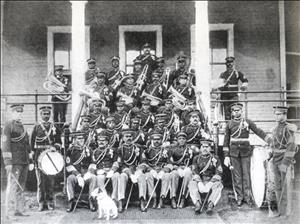On October 5, 1909, 900 men of the U.S. Army's 25th Infantry Regiment are transferred to Fort Lawton from the Philippines. (Seattle's Fort Lawton is on Magnolia Bluff overlooking Puget Sound in what will become Discovery Park.) The 25th is one of four regiments of African American soldiers in the Army, called Buffalo Soldiers by Plains Indians in the 1870s and 1880s. Two battalions will move on to Fort George Wright near Spokane. The soldiers at Fort Lawton and their families, who arrived the following year, will constitute approximately one-third of the Black population of Seattle (about 2,400 persons in 1910) during the years they stationed there. Filipinos who enlisted in the U.S. Army were in the regiment as well. In 1913, the 25th Infantry Regiment was transferred to Hawaii.
Less well known than the 9th and 10th Cavalry Regiments, the 25th Infantry Regiment was distinguished by its baseball team, which won several U.S. Army championships and was rated the best non-professional team in the country. In the Army, which was segregated, African Americans could compete against whites only in athletics. The U.S. Army remained segregated until 1948. The 25th regiment also had an outstanding band. Principal Musician Leslie V. King (1878-1963) graduated at the top of his class from the Washington Conservatory of Music in Seattle in 1910 and he became one of the few African American officers in the Army (King served in the U.S. Army from 1898 to 1935).

